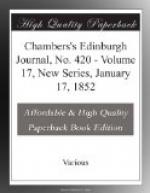‘What!’ exclaimed Rembrandt, ’efface the finest figure in the picture? No, indeed; I prefer keeping the piece for myself.’ Which he did, and carried off the painting.
Of Rembrandt’s style it may be said that he painted with light, for frequently an object was indicated merely by the projection of a shadow on a wall. Often a luminous spot suggested, rather than defined, a hand or a head. Yet there is nothing vague in his paintings: the mind seizes the design immediately. His studio was a circular room, lighted by several narrow slits, so contrived that rays of sunshine entered through only one at a time, and thus produced strange effects of light and shade. The room was filled with old-world furniture, which made it resemble an antiquary’s museum. There were heaped up in the most picturesque confusion curious old furniture, antique armour, gorgeously-tinted stuffs; and these Rembrandt arranged in different forms and positions, so as to vary the effects of light and colour. This he called ’making his models sit to him.’ And in this close adherence to reality consisted the great secret of his art. It is strange that his favourite amongst all his pupils was the one whose style least resembled his own—Gerard Douw—he who aimed at the most excessive minuteness of delineation, who stopped key-holes lest a particle of dust should fall on his palette, who gloried in representing the effects of fresh scouring on the side of a kettle.
Rembrandt died in 1674, at the age of sixty-eight. He passed all his life at Amsterdam. Some of his biographers have told erroneously that he once visited Italy: they were deceived by the word Venetiis placed at the bottom of several of his engravings. He wrote it there with the intention of deluding his countrymen into the belief that he was absent, and about to settle in Italy—an impression which would materially raise the price of his productions. Strange and sad it is to see so much genius united with so much meanness—the head of fine gold with the feet of clay.[4]
* * * * *
[Footnote 3: This picture is believed to be no longer in existence. I have found its description in the work of the historian Decamps.]
[Footnote 4: Abridged from the French of J. de Chatillon.]
ELECTIONEERING CURIOSITY.
[In giving the following address of an American candidate, we must beg our readers to understand that it is not intended as a joke. Electioneering in the States, generally speaking, is carried on with good-humour; and when there is no real cause of squabbling, the object of the aspirant is to get the laugh in his favour. The orator we introduce to the English public is Mr Daniel R. Russell, a candidate for the Auditorship in Mississippi.]
LADIES AND GENTLEMEN—I rise—but there is no use telling you that; you know I am up as well as I do. I am a modest man—very—but




